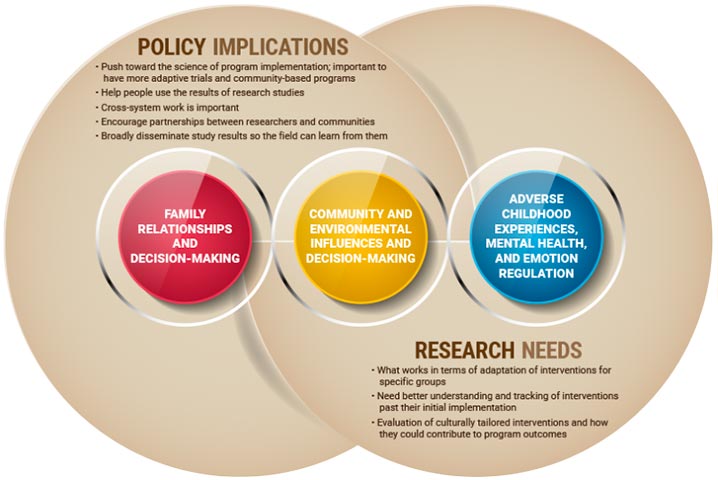Youth who receive special education services under the Individuals with Disabilities Education Act (IDEA 2004) and especially young adults of transition age, should be involved in planning for life after high school as early as possible and no later than age 16. Transition services should stem from the individual youth’s needs and strengths, ensuring that planning takes into account his or her interests, preferences, and desires for the future.
Adolescent Decision-Making Research
Adolescent Decision-Making Call for Research
In 2019 the American Institutes for Research (AIR) issued a Call for Manuscript Proposals for work on an initiative funded under a contract issued by the Office of the Assistant Secretary for Planning and Evaluation (ASPE) to support the work of the Interagency Working Group on Youth Programs (IWGYP). The specific focus of this call for manuscript proposals was on topics related to adolescent and young adult decision-making especially with regard to recognized risk behaviors and the implications of this decision-making for decisions about family planning, healthy relationships, sexual activity and general reproductive health.
Background
Recent discoveries in brain development offer new insights into how the adolescent brain works. Through imaging, neuroscientists have identified two networks in the frontal lobe of the brain that impact adolescent behavior and choices. The emotional network dominates the cognitive network during adolescence impacting two factors important in contraceptive use and pregnancy prevention — planning and risk assessment. During adolescence, the cognitive network that governs planning, thinking ahead, and self-regulation matures gradually. Under normal conditions, the cognitive network can regulate the social/emotional network. However, when the social/emotional network is highly activated, they do not work together. The emotional network dominates the cognitive network. The result is that emotion, rather than reason, often influences adolescent decision-making.
Infographic
The following infographic summarizes the manuscripts completed through this call for proposals. The manuscripts are categorized into three areas related to sexual decision-making: family relationships; community and environmental influences; and adverse childhood experiences, mental health, and emotional regulation. Click on the red, yellow, and blue circles below to read the abstracts of the research conducted for each category in response to the Call for Manuscripts.

Other Resources on this Topic
Agencies
Announcements
Collaboration Profiles
Data Sources
Departments
Feature Articles
Programs
Publications
Resources
Technical Assistance
Tools & Guides
Training Resources
Videos & Podcasts
Websites
Youth Topics
Youth Briefs
Research links early leadership with increased self-efficacy and suggests that leadership can help youth to develop decision making and interpersonal skills that support successes in the workforce and adulthood. In addition, young leaders tend to be more involved in their communities, and have lower dropout rates than their peers. Youth leaders also show considerable benefits for their communities, providing valuable insight into the needs and interests of young people
Statistics reflecting the number of youth suffering from mental health, substance abuse, and co-occurring disorders highlight the necessity for schools, families, support staff, and communities to work together to develop targeted, coordinated, and comprehensive transition plans for young people with a history of mental health needs and/or substance abuse.
Nearly 30,000 youth aged out of foster care in Fiscal Year 2009, which represents nine percent of the young people involved in the foster care system that year. This transition can be challenging for youth, especially youth who have grown up in the child welfare system.
Research has demonstrated that as many as one in five children/youth have a diagnosable mental health disorder. Read about how coordination between public service agencies can improve treatment for these youth.
Civic engagement has the potential to empower young adults, increase their self-determination, and give them the skills and self-confidence they need to enter the workforce. Read about one youth’s experience in AmeriCorps National Civilian Community Corps (NCCC).






